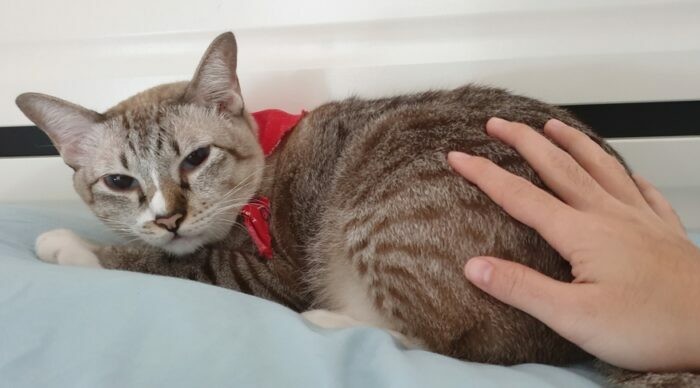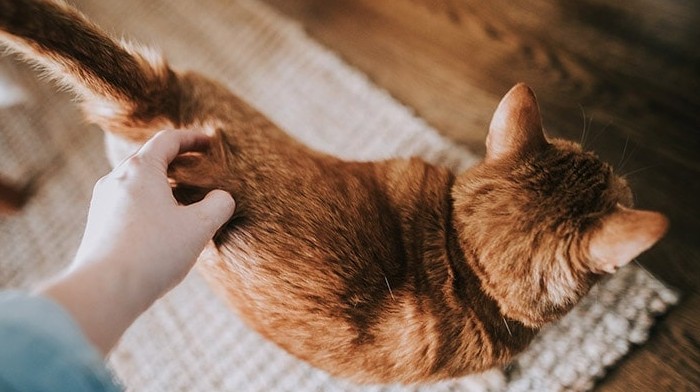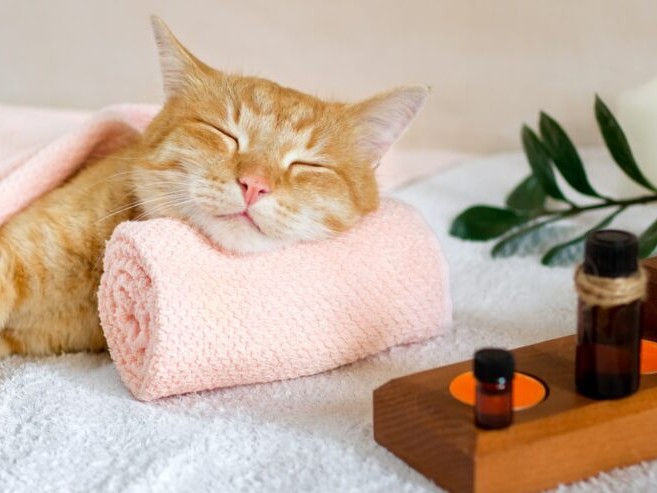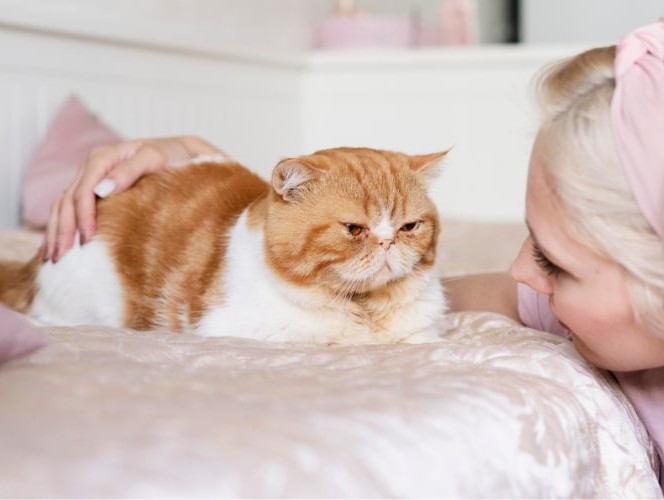Ever wonder why your whiskered friend can’t get enough of those sneaky butt pats? It’s a head-scratcher that’s puzzled cat lovers for ages. Join us as we unravel the mystery behind this curious behavior and delve into the world of whiskers and wiggles.

Get ready to explore the enchanting realm of feline fascination, where every pat holds a clue to our four-legged companions’ quirky ways. Let’s dive in and decode the captivating phenomenon of cats and their irresistible rear-end rendezvous! 🐱🤔
Reasons Why Your Cat Likes Butt Pats!
Butt Pats Stimulate Your Cat’s Senses
Cats enjoy butt pats because they enhance their senses, particularly their perceptions of touch and smell. Cats’ tails and hips have a lot of nerve endings that are sensitive to pressure and temperature.
When you pat them on the buttocks, a delightful sensation spreads throughout their body. They may feel relaxed, cheerful, or even aroused as a result of this.

Butt pats also improve your cat’s sense of smell, which is essential for them. Cats have a vomeronasal organ (VNO)[1] in their mouth that may sense pheromones and other chemical messages from other animals and humans.
Patting your cat on the buttocks transfers some of your fragrance to their fur, which they can lick and assess with their VNO. This can help them recognize you as a friend and family member, so strengthening your link.
Cats also enjoy butt pats because they strengthen their social bonds with you and other cats. Cats are gregarious creatures who want physical contact and affection from their human companions.
They frequently groom, rub against, and sleep together to demonstrate their trust and love. Butt pats are an extension of this practice since they demonstrate attention and concern.
Butt pats also indicate to you and other cats your cat’s emotions and intentions. For example, when you pat your cat on the buttocks, they are indicating that they are happy, calm, and friendly.
Butt Pats Help Your Cat Release Tension or Aggression
A third reason cats enjoy butt pats is that they help them relieve tension or hostility. Cats can be stressed or frustrated by a variety of circumstances, including boredom, loneliness, disease, or confrontation with other cats or people. Scratching, biting, hiding, or spraying may be displayed by agitated or upset animals.

Butt pats can help your cat cope with bad emotions by giving them a place to vent their energy and hostility. You can assist them relieve some of their pent-up stress and calm them down by softly or firmly patting them on the buttocks (depending on what they like). You can also divert their attention away from whatever is hurting them.
Butt Pats May Have a Sexual Component
Arousing the Reflex: Nature’s Intrigue
Female cats have a fascinating reflex called the “lordosis reflex.”[2] Because of this instinct, they arch their backs and raise their tails, exposing their most private areas. It’s a sign that they’re ready to mate, a dance of seduction entrenched in their instincts.
Unveiling Excitement: Butt Pats’ Role
A gentle stroke on the back of a female cat might stimulate this reflex, causing a hint of arousal or excitement.
This could explain the loud meows and playful rolls that occasionally follow. It’s important to recognize, however, that this is not an invitation for romantic intentions; rather, it’s a reaction to an underlying want.
How To Pat Your Cat
The Gentle Approach to a Harmonious Bond
Figuring out their indications is essential before embarking on a path of cat connection. Avoid times like sleep, eating, and grooming in favor of moments of leisure and play.
Delicate Introduction as a Gateway to Interaction
Contact should be made with caution, enabling them to become comfortable with your hand. Begin with gentle strokes over their head, neck, and back.

Crafting Link: The Subtle Technique
Tenderness is the art – use a soft touch and a gradual motion. To create an interesting aural experience, experiment with an open palm or a cupped hand.
Decoding Feedback: Understanding Their Language
Keep an eye out for purring, tail wags, or soft nudges that indicate contentment. If hisses, growls, or a quick retreat follow, it’s time to come to a halt.[3]
Respecting Their Space: A Fine Balance
Always respect their comfort zone. Respect any resistance that arises. Allow them to breathe by avoiding undue contact.
The Do’s And Don’ts
Do’s
- Do read their mood and take the lead.
- Approach them carefully and allow them to take notice.
- Touch with caution, matching their pace.
- Do adapt in response to their affection.
- Respect their space and their authority.
Don’ts
- Don’t startle or impose your plea.
- Don’t strike or push them past their limits.
- Don’t begrudge them if they’re not interested.
- Don’t overdo it, and avoid monotony.
- Don’t ignore their cues, and if you do, apologize.
FAQs
Q1: Why do some cats seem to enjoy butt pats more than others?
A: Just like humans, cats have distinct personalities. Some might revel in the sensory experience of butt pats, while others prefer different forms of affection. It often depends on their unique temperament and history.
Q2: Can I pat my cat’s butt whenever I want?
A: Reading your cat’s body language is key. Opt for moments of relaxation and play, avoiding times like sleep or meals. Always respect their cues – if they’re not receptive, it’s best to give them space.
Q4: Are butt pats the only way to bond with my cat?
A: Not at all! Cats have diverse preferences. While some enjoy butt pats, others might prefer head scratches, playtime, or belly rubs. Pay attention to what resonates with your feline friend.
Q5: Should I be concerned if my cat doesn’t seem to like butt pats?
A: It’s perfectly normal. Just as we have personal boundaries, so do our feline companions. Respecting their comfort zone and finding other ways to bond can strengthen your connection.
Q6: Can butt pats be a form of communication between me and my cat?
A: Absolutely! Cats use body language to convey emotions and intentions. Your cat’s reactions to butt pats can tell you a lot about their mood and preferences.
Q7: Is there a specific technique for patting a cat’s butt?
A : Yes, it’s important to approach gently, use a light touch, and observe their response. Slow and gradual interactions, coupled with an understanding of their cues, create a harmonious experience.
Q8: Can butt pats help reduce my cat’s stress or aggression?
A : Yes, in some cases. Butt pats can provide an outlet for pent-up energy or frustration. However, it’s crucial to read your cat’s reactions – if they seem agitated, it might be best to explore other stress-relief methods.
Q9: Can butt pats strengthen the bond between me and my cat?
A: Absolutely! Butt pats can be a way to express affection and reinforce the bond you share. When done with respect and consideration for your cat’s preferences, they can enhance your relationship.
Q10: Should I consult a veterinarian if my cat consistently reacts negatively to butt pats?
A: If you notice persistent signs of discomfort or unusual behavior, it’s always a good idea to consult a veterinarian. They can help rule out any underlying medical issues and provide guidance on your cat’s well-being.
Conclusion
Cat butt pats, which appear basic but are surprisingly enticing, provide a unique view into the delicate world of feline relationships. These soft motions, like a whispered secret between you and your cat, excite their senses, express a language beyond words, and allow them to connect with their primitive impulses.
Each touch on the back becomes a thread in the intricate tapestry of your personal link, joining you both in a silent and beautiful dance of affection, a symphony of pleasure, communication, and individuality.
References:
- Salazar, I. (1996, April 1). The vomeronasal organ of the cat. PubMed Central (PMC).
- VanderHorst, V., & Holstege, G. (1997). Estrogen induces axonal outgrowth in the nucleus Retroambiguus–Lumbosacral motoneuronal pathway in the adult female cat. The Journal of Neuroscience, 17(3), 1122–1136. butt-patting-cats
- Morrison, B. J., DVM. (2022). Cat hissing: What you need to know. PetMD.

